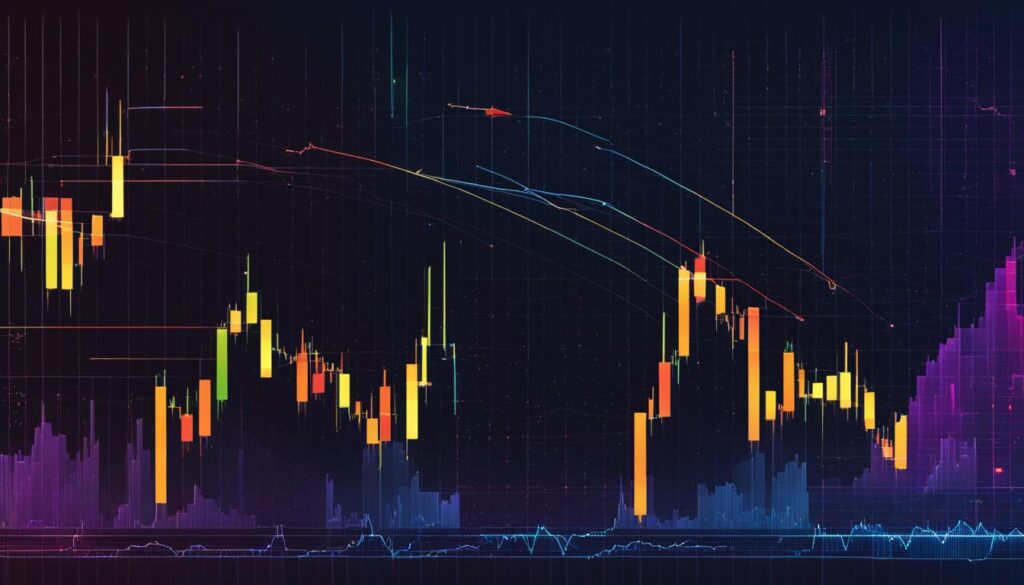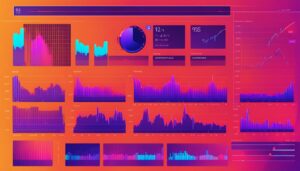Greetings! In this article, I will take you on an exciting journey to uncover what is traded in the world of Forex. As we delve into the depths of forex trading, you will gain a deeper understanding of the forex market and the role played by forex brokers.
Forex, also known as FX, is a global electronic marketplace where international currencies and currency derivatives are traded. With trillions of dollars changing hands every day, forex trading has emerged as the largest and most liquid market in the world.
When it comes to forex trading, currencies are traded in pairs, such as USD/CAD, EUR/USD, or USD/JPY. In each currency pair, one currency is bought while the other is sold. This dynamic creates opportunities for traders to profit from the price movements of currency pairs.
The forex market operates 24 hours a day, five days a week, providing round-the-clock access through banks, brokers, and financial institutions. It offers a wide range of trading opportunities with various currency pairs, allowing traders to explore diverse strategies and techniques.
So, whether you are a seasoned trader or just starting your forex journey, understanding what is traded in forex markets is crucial for success. Now, let’s delve deeper into the fascinating world of forex trading and equip ourselves with the knowledge and skills to make informed trading decisions.
Key Takeaways:
- Forex, or FX, is a global marketplace for trading international currencies and currency derivatives.
- Forex trading involves buying one currency and selling another in currency pairs.
- The forex market is the largest and most liquid market in the world, with trillions of dollars traded daily.
- Forex trading is accessible 24 hours a day, five days a week through banks, brokers, and financial institutions.
- Understanding what is traded in forex markets is essential for successful trading.
Understanding Forex (FX)
As a forex trader, I rely on various analysis techniques to determine the optimal entry and exit points for my trades. The forex market offers the opportunity to speculate on the direction of currency values, allowing traders like me to profit from the fluctuation in price movements of currency pairs. These currency pairs are listed as combinations of currencies, such as USD/CAD, EUR/USD, or USD/JPY.
Forex trading strategies are diverse, and they can involve technical analysis, fundamental analysis, or a combination of both. Technical analysis involves analyzing historical price data and using indicators to predict future price movements, while fundamental analysis focuses on evaluating economic indicators, news events, and geopolitical factors that affect currency values.
Understanding different forex trading strategies is crucial for success in this dynamic market. By combining technical and fundamental analysis, traders are well-equipped to make informed trading decisions and capitalize on market opportunities.
For instance, technical analysis techniques such as trend following, support and resistance levels, and chart patterns help me identify potential entry and exit points for my trades. On the other hand, fundamental analysis considers economic indicators like GDP, inflation rates, and central bank decisions to gauge the overall economic health of a country and make trading decisions based on broader market conditions.
The forex market is a fast-paced and ever-changing environment, and staying updated with market news and events is essential. By keeping a close eye on economic calendars, central bank announcements, and geopolitical developments, traders can adjust their strategies and take advantage of significant market movements.
Choosing the Right Forex Trading Strategy
When it comes to selecting a forex trading strategy, it’s crucial to find an approach that aligns with your trading style, risk tolerance, and financial goals. Some traders prefer shorter-term strategies, such as day trading or scalping, while others opt for longer-term strategies like swing trading or position trading.
Day trading involves opening and closing positions within the same trading day, capitalizing on small price movements. Scalping, on the other hand, focuses on making quick profits from small price fluctuations, often within seconds or minutes. Swing trading involves holding positions for a few days to weeks, aiming to capture larger price swings, while position trading involves holding positions for weeks to months, benefiting from long-term trends.
It’s important to note that no strategy guarantees success in the forex market. Traders need to continuously adapt their strategies based on changing market conditions and stay disciplined in their approach. Consistent risk management, proper money management, and a strong understanding of technical and fundamental analysis are vital components of a successful forex trading strategy.
Enhancing Forex Trading Strategies with Technology
The advancement of technology has significantly impacted the forex market, offering traders an array of tools to enhance their trading strategies. Automated trading systems, also known as forex robots or expert advisors (EAs), can execute trades based on pre-defined rules, removing the emotional aspect from trading. These systems can backtest strategies, identify suitable entry and exit points, and execute trades automatically.
| Advantages of Automated Trading Systems | Disadvantages of Automated Trading Systems |
|---|---|
|
|
Automated trading systems can be a valuable tool for traders, but it’s important to understand their limitations and monitor their performance to ensure they align with your trading goals.
Furthermore, the availability of advanced charting platforms, real-time market data, and mobile trading apps enables traders to analyze the market, execute trades, and manage their portfolios from anywhere at any time.
By leveraging technology to support their trading strategies, forex traders can gain a competitive edge and optimize their decision-making process in this fast-paced market.
Forex Lots and Trading Volume
In the forex market, currencies trade in lots, which represent standardized units of currency. These lots help to provide consistency in trading and facilitate efficient transactions. There are different lot sizes available for traders to choose from, depending on their trading capital and risk tolerance.
The most common lot sizes in the forex market are:
| Lot Size | Number of Units |
|---|---|
| Micro | 1,000 units |
| Mini | 10,000 units |
| Standard | 100,000 units |
Trading volume in the forex market is massive, with over $5 trillion traded per day. This high volume of trading activity creates ample opportunities for traders to enter and exit positions, ensuring liquidity and minimizing the impact of price fluctuations.
To participate in forex trading, traders can utilize various trading platforms offered by brokers. These platforms provide access to real-time market data, charting tools, and the ability to execute trades. Choosing the right forex trading platform is essential for a seamless trading experience.
To enhance their trading performance, traders can also make use of different strategies and tips. These may include technical analysis techniques, such as identifying chart patterns and utilizing indicators, or fundamental analysis methods, which involve monitoring economic and geopolitical events that could impact currency prices.
Remember, successful forex trading requires discipline, knowledge, and experience. It is essential to continuously educate oneself about market trends, risk management strategies, and evolving trading techniques.
Investing time in learning and staying updated with market developments can greatly improve your chances of success in the forex market.
Forex Market Locations
The forex market is a global marketplace for trading currencies, and it operates in major financial centers around the world. Traders can participate in the forex market from various locations, taking advantage of different time zones and trading hours.
Some of the largest forex markets are:
- London: As the financial capital of Europe, London plays a significant role in the forex market. It is known for its high liquidity and trading volume.
- New York: Being one of the major financial hubs, New York contributes significantly to the forex market. The market hours overlap with those of London, creating a period of high trading activity.
- Singapore: As a major financial center in the Asia-Pacific region, Singapore attracts forex traders from around the world. It is well-positioned geographically, making it a hub for Asian market trading.
- Tokyo: Tokyo is another prominent forex market location in Asia. It has a large share in the forex market, especially during the Asian trading session.
- Frankfurt: As the financial capital of Germany and a leading European financial center, Frankfurt has a significant impact on the forex market, particularly during the European trading session.
- Hong Kong: Known for its robust financial industry, Hong Kong provides a gateway to the Asian market. It attracts traders from both the East and the West.
- Sydney: As the financial center of Australia, Sydney serves as a major forex market location in the Asia-Pacific region. It features prominently during the Asian trading session.
The forex market operates 24 hours a day, five days a week, allowing traders to buy and sell currencies at any time. The trading hours may vary slightly depending on the location and time zone. Traders can take advantage of different trading sessions, such as the Asian, European, and North American sessions, to capitalize on market volatility and liquidity.
To illustrate the trading sessions in different locations, here’s a visual representation:
| Trading Session | Location | Operating Hours (UTC) |
|---|---|---|
| Asian Session | Tokyo, Hong Kong, Singapore | 00:00 – 09:00 |
| European Session | London, Frankfurt | 07:00 – 16:00 |
| North American Session | New York | 12:00 – 21:00 |
Understanding the forex market locations and trading hours is crucial for forex traders, as it allows them to determine the most active and volatile periods for trading. By aligning their trading activities with these sessions, traders can increase their chances of success in the forex market.
Forex Trading Instruments
In addition to trading currency pairs, the forex market offers a wide range of financial instruments that traders can utilize. These instruments provide opportunities to diversify trading strategies and explore different asset classes within the forex market.
Commodities
One of the forex trading instruments available is commodities. Traders can speculate on the price movements of commodities such as gold, oil, silver, or natural gas. Commodities often exhibit unique market dynamics influenced by factors like supply and demand, geopolitical events, and economic indicators. Including commodities in your trading portfolio can offer exposure to different market conditions and potentially enhance trading opportunities.
Stock Market Indices
Forex traders can also participate in trading stock market indices. Popular indices like the S&P 500, FTSE 100, or NASDAQ represent baskets of stocks that track the performance of specific market sectors or economies. Trading stock market indices in the forex market allows traders to access global equity markets without the need for direct stock ownership. It can be an effective way to diversify risk and capitalize on broader market trends.
Bonds
Bonds, specifically government treasury bonds, are another financial instrument available for trading in the forex market. Government bonds are debt securities issued by governments to finance public spending. Trading government bonds can provide opportunities to capture interest rate differentials and react to economic and political developments affecting the bond markets. It’s an avenue for traders to explore fixed-income assets within the forex market.
Forex Trading Signals
Forex trading signals are a valuable tool used by traders to help identify potential trading opportunities. These signals can be generated by experienced traders, algorithmic systems, or technical analysis indicators. Trading signals provide traders with guidance on when to enter or exit trades based on predefined criteria. They assist in making informed trading decisions and can be used alongside individual trading strategies to enhance overall performance.
By incorporating these forex trading instruments into their strategies, traders can broaden their horizons and potentially uncover new trading opportunities within the dynamic forex market.

Forex Market Participants
The forex market is a dynamic ecosystem that involves various participants working together to facilitate currency trading. Understanding these participants is crucial for anyone looking to navigate the forex market effectively.
Let’s take a closer look at the key players in the forex market:
Banks and Financial Institutions
As major market participants, banks and financial institutions play a vital role in forex trading. They act as intermediaries for large transactions, facilitating the movement of currencies between different countries. These institutions have direct access to the interbank market, where they can obtain favorable exchange rates and execute trades on behalf of their clients.
Forex Brokers
Forex brokers provide individual traders with access to the forex market through trading platforms. They act as intermediaries between traders and liquidity providers, such as banks and financial institutions. Forex brokers offer a range of services, including account types, leverage options, educational resources, and customer support to cater to the diverse needs of traders.
Individual Traders
Individual traders, also known as retail traders, are the backbone of the forex market. They are everyday people like you and me who trade currencies to profit from price movements. With the advancement of technology, individual traders now have easy access to the forex market through trading platforms provided by brokers. They can execute trades, analyze market trends, and manage their portfolios from the comfort of their homes.
Now, let’s visualize the relationship between these participants in a clear and informative table:
| Forex Market Participants | Roles and Responsibilities |
|---|---|
| Banks and Financial Institutions | Act as intermediaries for large transactions, provide liquidity, and facilitate currency exchange. |
| Forex Brokers | Provide individual traders with access to the forex market through trading platforms, offer various services and support. |
| Individual Traders | Trade currencies to profit from price movements, utilize trading platforms to manage their trades and portfolios. |
By understanding the roles and interactions between these participants, traders can make informed decisions and navigate the forex market with more confidence.
Forex Market Regulation and Risks
When it comes to the forex market, it’s important to note that it is not as regulated as other financial markets, such as stocks or futures. This lack of central regulation means that as a trader, I need to exercise caution and choose reputable forex brokers to ensure the security of my investments. Trustworthy brokers play a crucial role in providing a transparent trading environment and safeguarding my funds.
Forex trading, like any investment, carries inherent risks that I must be aware of. One of the primary risks is the volatility of the forex market itself. Currencies fluctuate in value constantly, influenced by various economic, political, and social factors. As a result, prices can change rapidly, presenting both opportunities and pitfalls. To navigate this volatility successfully, I need to remain informed and stay updated on market trends.
Another risk associated with forex trading is leverage. Leverage allows me to control large positions with a relatively smaller amount of capital. While leverage can amplify potential gains, it can also magnify losses. Therefore, I must use leverage wisely and understand the potential consequences before taking on significant positions.
Counterparty risk is yet another factor to consider. In forex trading, I depend on brokers and financial institutions to facilitate my trades. If a broker or institution experiences financial difficulties or goes bankrupt, there is a risk of losing my funds. To mitigate this risk, I carefully choose brokers that are regulated by reputable authorities and maintain segregated client accounts.
To protect myself from these risks, I need to have a thorough understanding of forex market dynamics and implement proper risk management strategies. This includes setting realistic goals, using stop-loss orders, diversifying my portfolio, and continuously educating myself about market trends and trading strategies.
“Success in forex trading lies in understanding the inherent risks and managing them effectively.”
Regulatory Bodies and Forex Market Oversight
The forex market is overseen by various regulatory bodies around the world. These organizations play a critical role in ensuring fair practices and protecting the interests of traders. Some important regulatory bodies include:
- Commodity Futures Trading Commission (CFTC) in the United States
- Financial Conduct Authority (FCA) in the United Kingdom
- Australian Securities and Investments Commission (ASIC) in Australia
- Financial Services Agency (FSA) in Japan
Regulated brokers from these jurisdictions adhere to specific standards and guidelines, providing traders with added confidence and security. When choosing a forex broker, I make sure to verify their regulatory status and reputation to ensure a safe trading environment.
Now that I understand the regulatory landscape and the risks involved, I can proceed with greater confidence, armed with the knowledge needed to navigate the forex market effectively.
| Forex Market Regulation and Risks | |
|---|---|
| Forex Market Regulation | Risks Associated |
| Not as regulated as stocks or futures markets | Volatility of the forex market |
| Choose reputable forex brokers | Leverage and potential losses |
| Be aware of counterparty risk | Importance of risk management |
| Regulatory bodies and oversight |
Conclusion
The forex market is a dynamic and lucrative marketplace for trading international currencies. As a trader, it is crucial to have a comprehensive understanding of what is traded in the forex market, including currency pairs and other financial instruments. By staying informed about market trends and utilizing effective forex trading strategies, individuals can seize profitable opportunities.
However, it is important to acknowledge the risks associated with forex trading. Volatility, leverage, and counterparty risk are inherent to the market, and traders must exercise caution. Choosing a reputable forex broker is paramount, as it ensures fair trading conditions and reliable execution of trades.
To navigate the forex market successfully, traders should develop a solid trading strategy that aligns with their risk appetite and financial goals. Incorporating risk management techniques is essential to protect investments and mitigate potential losses. By utilizing the right tools, knowledge, and strategies, traders can participate in the forex market with confidence, aiming for profitability and long-term success.
FAQ
What is traded in the forex market?
In the forex market, international currencies and currency derivatives are traded. Traders buy and sell currency pairs, such as USD/CAD, EUR/USD, or USD/JPY.
What is forex trading?
Forex trading refers to the act of buying and selling currencies in the forex market to profit from the price movement of currency pairs.
What are forex currency pairs?
Forex currency pairs represent combinations of currencies that are traded in the forex market, such as USD/CAD, EUR/USD, or USD/JPY.
What are forex trading strategies?
Forex trading strategies are techniques used by traders to analyze the market and find the best entry and exit points for their trades. These strategies can involve technical analysis, fundamental analysis, or a combination of both.
What are forex lots and trading volume?
Forex lots represent standardized units of currency that are traded in the forex market. The most common lot sizes are micro (1,000 units), mini (10,000 units), and standard (100,000 units). Trading volume in the forex market is massive, with over $5 trillion traded per day.
What are the trading hours of the forex market?
The forex market operates 24 hours a day, five days a week. However, the trading hours may vary slightly depending on the location and time zone. The major trading centers are located in London, New York, Singapore, Tokyo, Frankfurt, Hong Kong, and Sydney.
What are the financial instruments traded in the forex market?
In addition to currency pairs, the forex market also offers trading opportunities for other financial instruments such as commodities (gold, oil), stock market indices (S&P 500, FTSE 100), and bonds (government treasury bonds).
Who participates in the forex market?
The forex market is accessed by a wide range of participants, including banks, brokers, financial institutions, and individual traders. Banks and financial institutions facilitate the majority of forex trading, while brokers provide platforms for individuals to trade currencies.
What are the risks and regulations in the forex market?
The forex market is not as regulated as other financial markets. Traders should be cautious and choose reputable brokers. Forex trading carries inherent risks, including volatility, leverage, and counterparty risk. It is important for traders to have a thorough understanding of these risks and implement proper risk management strategies.





